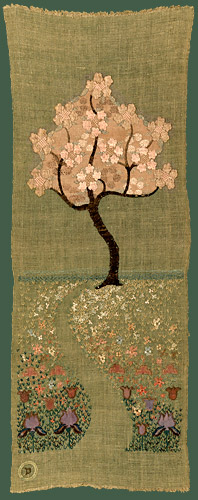Deerfield Arts & Crafts home page
Comparisons
Nature through Line, Color and 'Notan'


Deerfield Society of Blue and White Needlework designers Margaret Whiting and Ellen Miller soon incorporated a variety of early-twentieth-century design elements into their work. Their panel Rose Tree, for instance, suggests an understanding of the early modernist aesthetic espoused by Arthur Wesley Dow, an artist, author and teacher whose textbook Composition was widely used in art schools throughout the United States at the turn of the twentieth century. DSBWN's Rose Tree executed between 1910 and 1916 bears a striking resemblance to Dow's woodcut Bend of a River from 1898. Beyond the obvious similarities of subject matter and vertical orientation, each work beautifully transforms a natural motif into a harmonious composition whereby the careful use of line, color and what Dow called 'notan' (a compositional balancing of light and dark) elevate design considerations over a more traditional attempt at illusionistic naturalism. The resulting works of art celebrate the two dimensional nature of compositions that have been embroidered or printed onto flat linen or paper grounds.
Left image: Rose Tree, Deerfield Society of Blue & White Needlework, Memorial Hall Museum, Pocumtuck Valley Memorial Association
Right image: Bend of a River, Arthur Wesley Dow, Photograph © 2012 Museum of Fine Arts, Boston. Arthur Wesley Dow, American, 1857-1922, Bend of a River, about 1898, Color woodcut, 23.0 x 6.1 cm (9/1/16 x 2 3/8 in.), Museum of Fine Arts, Boston, Gift of Mrs. Ethelyn H. Putnam, 41.716